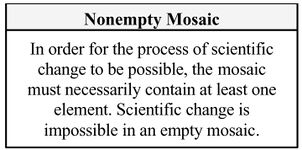Non-Empty Mosaic theorem (Barseghyan-2015)
This is an answer to the question Necessary Elements that states "In order for the process of scientific change to be possible, the mosaic must necessarily contain at least one element. That is, scientific change is impossible in an empty mosaic."
Non-Empty Mosaic theorem was formulated by Hakob Barseghyan in 2015.1
Scientonomic History
Acceptance Record
| Community | Accepted From | Acceptance Indicators | Still Accepted | Accepted Until | Rejection Indicators |
|---|---|---|---|---|---|
| Scientonomy | 1 January 2016 | The theorem became de facto accepted by the community at that time together with the whole theory of scientific change. | Yes |
Question Answered
Non-Empty Mosaic theorem (Barseghyan-2015) is an attempt to answer the following question:
See Necessary Elements for more details.
Description
The non-empty mosaic theorem asserts that in order for a process of scientific change to be possible, the mosaic must necessarily contain at least one element. Scientific change is impossible in an empty mosaic. It can be deduced from the second law, which asserts that in order to become accepted into the mosaic, a theory is assessed by the method actually employed at the time, and the third law, which asserts that a method becomes employed only when it is deducible from other employed methods and accepted theories of the time.1p. 226
Reasons
Reason: Deduction of the Non-Empty Mosaic theorem
Scientific change is impossible in an empty mosaic. It can be deduced from the second law, which asserts that in order to become accepted into the mosaic, a theory is assessed by the method actually employed at the time, and the third law, which asserts that a method becomes employed only when it is deducible from other employed methods and accepted theories of the time.1p. 226
This reason for Non-Empty Mosaic theorem (Barseghyan-2015) was formulated by Hakob Barseghyan in 2015.1
If a reason supporting this theory is missing, please add it here.
Questions About This Theory
There are no higher-order questions concerning this theory.
If a question about this theory is missing, please add it here.
